

Phrénologie. Un article de Wikipédia, l'encyclopédie libre.

Crâne phrénologique du XIXe siècle, Collection Gall (Musée d'anatomie de Lyon) La phrénologie est une théorie selon laquelle les bosses du crâne d'un être humain reflètent son caractère. Franz Joseph Gall. Un article de Wikipédia, l'encyclopédie libre. Pour les articles homonymes, voir Gall. Johann Gaspar Spurzheim. Un article de Wikipédia, l'encyclopédie libre.
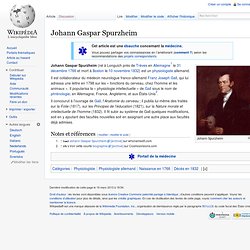
Johann Spurzheim Il est collaborateur du médecin neurologue franco-allemand Franz Joseph Gall, qui lui adressa une lettre en 1798 sur les « fonctions du cerveau, chez l'homme et les animaux ». Il popularisa la « physiologie intellectuelle » de Gall sous le nom de phrénologie, en Allemagne, France, Angleterre, et aux États-Unis[2]. Il concourut à l'ouvrage de Gall, l'Anatomie du cerveau ; il publia lui-même des traités sur la Folie (1817), sur les Principes de l'éducation (1821), sur la Nature morale et intellectuelle de l'homme (1832).
Il fit subir au système de Gall quelques modifications, soit en y ajoutant des facultés nouvelles soit en assignant une autre place aux facultés déjà admises. Jean-François Champollion. Jean-François Champollion (23 December 1790 – 4 March 1832) was a French scholar, philologist and orientalist, decipherer of the Egyptian hieroglyphs.

Biography[edit] Champollion was the last of seven children (two of whom died before he was born). He was raised in humble circumstances; because his parents could not afford to send him to school, he was taught to read by his brother Jacques. Rosetta Stone. Ever since its rediscovery, the stone has been the focus of nationalist rivalries, including its transfer from French to British possession during the Napoleonic Wars, a long-running dispute over the relative value of Young and Champollion's contributions to the decipherment, and since 2003, demands for the stone's return to Egypt.
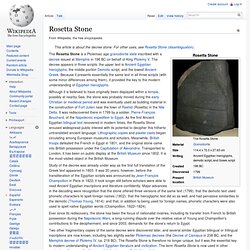
Description[edit] Original stele[edit] One possible reconstruction of the original stele The Rosetta Stone is a fragment of a larger stele. No additional fragments were found in later searches of the Rosetta site.[9] Owing to its damaged state, none of the three texts is absolutely complete. The full length of the hieroglyphic text and the total size of the original stele, of which the Rosetta Stone is a fragment, can be estimated based on comparable stelae that have survived, including other copies of the same order. Suggest that it originally had a rounded top.[7][13] The height of the original stele is estimated to have been about 149 centimetres (59 in).[13] William Jones (mathematician) William Jones was born the son of Siôn Siôr (John George Jones) and Elizabeth Rowland in the parish of Llanfihangel Tre'r Beirdd, about 4 miles west of Benllech on the Isle of Anglesey.
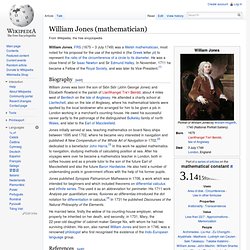
He attended a charity school at Llanfechell, also on the Isle of Anglesey, where his mathematical talents were spotted by the local landowner who arranged for him to be given a job in London working in a merchant's counting-house. He owed his successful career partly to the patronage of the distinguished Bulkeley family of north Wales, and later to the Earl of Macclesfield. Jones published Synopsis Palmariorum Matheseos in 1706, a work which was intended for beginners and which included theorems on differential calculus and infinite series. This used π as an abbreviation for perimeter. His 1711 work Analysis per quantitatum series, fluxiones ac differentias introduced the dot notation for differentiation in calculus.[4] In 1731 he published Discourses of the Natural Philosophy of the Elements. Johann Kaspar Lavater. William Jones (philologist) A steel engraving of Sir William Jones, after a painting by Sir Joshua Reynolds.
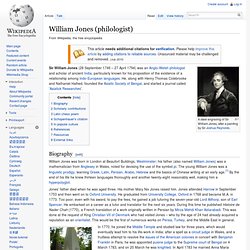
Sir William Jones (28 September 1746 – 27 April 1794) was an Anglo-Welsh philologist and scholar of ancient India, particularly known for his proposition of the existence of a relationship among Indo-European languages. He, along with Henry Thomas Colebrooke and Nathaniel Halhed, founded the Asiatic Society of Bengal, and started a journal called 'Asiatick Researches'. Jones' father died when he was aged three. His mother Mary Nix Jones raised him. Jones attended Harrow in September 1753 and then went on to Oxford University. Jones was a radical political thinker, a friend of American independence. In the Subcontinent he was entranced by Indian culture, an as-yet untouched field in European scholarship, and on 15 January 1784 he founded the Asiatic Society in Calcutta.
Praire. Un article de Wikipédia, l'encyclopédie libre.
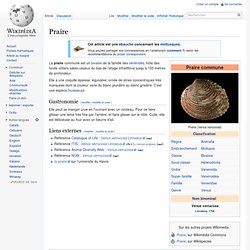
La praire commune est un bivalve de la famille des vénéridés, hôte des fonds côtiers sablo-vaseux du bas de l’étage infralittoral jusqu’à 100 mètres de profondeur. Elle a une coquille épaisse, équivalve, ornée de stries concentriques très marquées dont la couleur varie du blanc jaunâtre au blanc grisâtre. C’est une espèce fouisseuse. Gastronomie[modifier | modifier le code] Elle peut se manger crue en l'ouvrant avec un couteau.
Prairie - Ishmailites. All, This chapter, "The Prairie," has a name which has always mystified me, since the word is not used in the chapter.

The chapter is definitely not about actual prairies. In my experience one writer seems to have an insight into Melville's metaphor. The following quotes are from The Great Prairie: Fact and Literary Imagination (1989) by Robert Thacker published by the University of New Mexico. "Herman Melville, in Moby-Dick, was the only writer of this period who used the prairie with anything like the depth and power of [James Fenimore] Cooper.
"Edwin Fussell has said that in Moby-Dick 'there are more references to the American West than to Polynesia (or England; or the ancient world; or the Near East; or the history of philosophy; or anything else); and all these references appear to head in one direction, as if arranging themselves along the lines of force in a pre-existing magnetic field. 1895-Dictionary-Phrenolog.png (PNG Image, 710x1200 pixels) - Sca. Power Moby-Dick, the Online Annotation — Chapter 79. Page 343 Physiognomist: a pseudo-scientist who seeks clues to a person's character by studying their face Phrenologist: a pseudo-scientist who seeks clues to a person's character by studying the shape of their skull Lavater: Johann Kaspar Lavater (1741-1801), a Swiss physiognomist Gall: Franz Joseph Gall (1758-1828), the founder of phrenology The Pantheon: a temple in Rome built to honor ancient gods, and since the 7th century used as a Catholic church.
